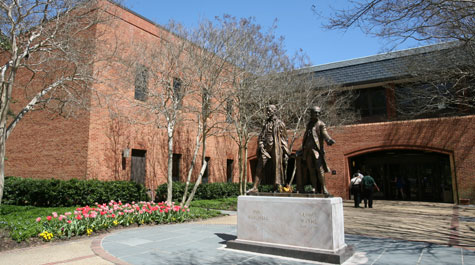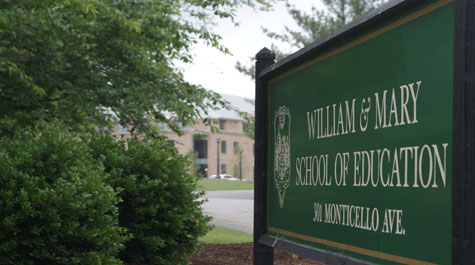Law, Education remain among nation's best in rankings
The William & Mary Law School and the School of Education both remained among the nation’s best according to U.S. News & World Report, though the magazine’s annual report on graduate and professional schools has generated lots of discussion regarding its methodology and statistics that resulted in some surprising fluctuations in the rankings.
In this year’s rankings, the Law School ranked 35th, tied with the University of Illinois and the University of Wisconsin. The School of Education also ranked among the nation’s best graduate programs in the survey, coming in at 43rd -- tied with the University of California-Irvine and Washington University-St. Louis. Both schools have consistently appeared among the top programs. Last year, the Law School ranked 27th, tied with Boston College and the University of Iowa in 2011. The school was 28th in 2010 and 2009 and 30th overall in 2008.
While the Law School’s ranking this year dropped to 35th, its overall score in U.S. News was 64, just one point off of last year’s total of 65.
“This year, one point separates us from the law school ranked 34th and two points separate us from five schools tied at 29th,” said Dean Davison M. Douglas. “I am disappointed with how we fared this year by the yardstick of the U.S. News rankings but the fact remains that William & Mary continues to be one of the nation’s great law schools.”
Douglas notes that the Law School actually improved in several key categories, including its reputation among lawyers and judges – a category in which it is ranked 22nd nationally, bar passage rate, and the quality of William & Mary students as measured by their undergraduate GPAs. The Law School also moved up one spot in the faculty peer assessment category.
So what contributed to the Law School’s move to 35th?
William & Mary’s drop in one category – the percentage of students employed nine months after graduation – was the primary reason. It’s also a category that has been the source of considerable national controversy.
Placement numbers
U.S. News looks at two data sets in regards to graduate employment: how many students have jobs at graduation and how many students have jobs nine months after graduation. The second statistic, the nine-month figure, carries by far the most weight in the tabulation of the overall rankings of law schools. Douglas said a small change in that nine-month employment figure has a tremendous impact on a school’s overall ranking. In the case of the Law School this year, the nine-month employment figure was 86.9 percent, approximately 7 percentage points lower than last year.
Douglas said the struggling economy is partially to blame for the lower placement figure, but that isn’t the entire story.
In response to declining employment rates, many law schools have recently decided to fund their own graduates in temporary, short-term positions – to make sure that their students can be considered employed on February 15, the nine-month-after-graduation date for U.S. News. William & Mary chose not to do so, and the result was a lower employment percentage compared to many of its peers.
“We do provide fellowships for up to 10 weeks to recent graduates who take jobs in public service after graduation as a way to help them get a start in their career,” Douglas said. But those 10-week fellowships end in the fall, and so do not affect the law school’s nine-month employment numbers which are based on the February 15 date.
Law school placement numbers were also skewed by the fact that U.S. News now considers students pursuing advanced degrees to be unemployed when calculating employment rates. Even though these advanced degrees, such as LLM degrees in taxation, generally make students more employable, U.S. News counts these students as not employed. William & Mary has a larger percentage of its graduates – about 4 percent -- pursue advanced degrees than do many of its peer schools – which further weakened its relative placement performance.
A growing controversy
U.S. News mentioned the ongoing employment controversy in its story on this year’s rankings, observing that there is “currently much controversy over the veracity of some schools placement data.” This year, for the first time, law schools were asked to disclose the number of graduates whose jobs were law-school funded, although U.S. News ultimately declined to exclude those graduates from the employment percentages.
Robert Morse, who is in charge of the rankings for U.S. News, addressed the placement controversy in a separate column. He said the magazine planned to provide more detailed placement information in next year’s rankings report: “The new, more granular reporting will reveal such vital information as how many graduates had jobs that are full time or part time, short term or long term and that actually require the J.D. degree. For future rankings, U.S. News intends to incorporate these improved data into our methodology and include them in our profiles of each law school’s latest graduating class.”
Douglas said that these changes are welcome news and will provide students with more detailed information about the employment percentages of law schools. In the meantime, Douglas said that the Law School will do all that it can to help all of its graduating students find permanent employment. “We’re not satisfied with our 86.9 percent employment figure,” Douglas said. “We will be re-evaluating our career services program, looking to add staff in that office and will be working to engage more alumni in the employment process.”
Maintaining momentum
U.S. News rankings aside, Douglas said there are plenty of other strong indicators of the Law School’s continued vitality, including its recent international conference in Beijing and the record-breaking $3.3 million raised during its FY 2011 fundraising campaign. In addition, he said, this has been one of law faculty’s most productive years as measured by publications in the nation’s premier law reviews and by scholarly presses. And this year’s newest group of students, the Class of 2014, is the strongest academic class in the history of the school when considering its median LSAT of 165 and the median undergraduate GPA of 3.73.
“This year’s U.S. News rankings do not reflect the true quality of this school,” he said. “The nation’s oldest law school is on an upward trajectory and we plan to maintain this momentum.”
At the School of Education, Dean Virginia McLaughlin said there is also plenty of momentum. The School of Education celebrated its 50th Anniversary last year following the fall 2010 opening of their new 113,000 square feet facility.
This year’s ranking of 43rd -- tied with the University of California-Irvine and Washington University-St. Louis -- followed a ranking of 41st last year and a ranking of 39th in 2010 when the school moved up nine spots from 48th in the 2009 survey. But there are also more to the numbers than appear at first glance, she added.
“Our reputational rankings by higher education peers and K-12 superintendents have remained incredibly strong,” McLaughlin said. “In the random survey of superintendents nationally, our W&M School of Education is tied for 6th place.”
U.S. News & World Report annually ranks graduate and professional school programs in education, law, medicine, engineering and business using a variety of scoring categories, such as peer assessments, student/faculty ratios and funding for faculty research. Highlights of the graduate school rankings are scheduled for publication in the 2013 version of the Best Graduate Schools book that will be available for purchase as of April 5. A complete list of the top rankings is available online.

















